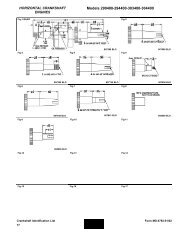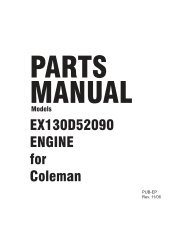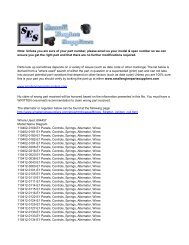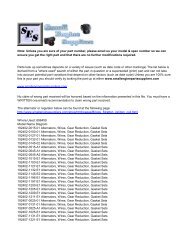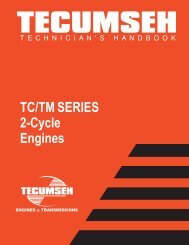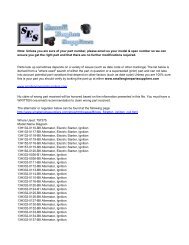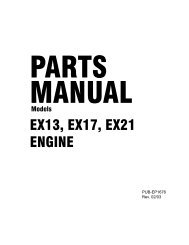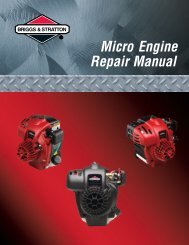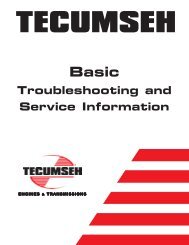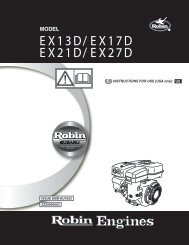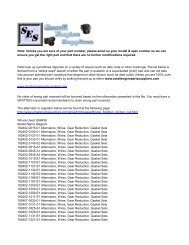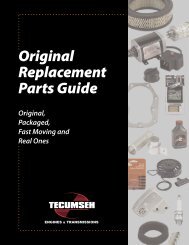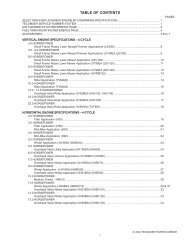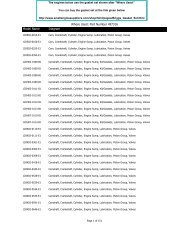3to 11hp 4-cycle l-head engines - Small Engine Suppliers
3to 11hp 4-cycle l-head engines - Small Engine Suppliers
3to 11hp 4-cycle l-head engines - Small Engine Suppliers
You also want an ePaper? Increase the reach of your titles
YUMPU automatically turns print PDFs into web optimized ePapers that Google loves.
TESTING<br />
1. After repeated efforts to start the engine using the procedure listed in the operator’s manual fail, check for spark by<br />
removing the high tension lead and the spark plug. Install a commercially available spark plug tester and check for<br />
spark. If spark is evident and acceptable, proceed to step 2. If no or weak spark, see Chapter 8 under "Testing".<br />
2. Visually inspect the spark plug for a wet condition indicating the presence of gasoline in the cylinder.<br />
3. If the spark plug is dry, check for restrictions in the fuel system before the carburetor. If the spark plug is wet,<br />
continue with step # 7. Check to see if the fuel cap vent is open. With a proper draining receptacle, remove the fuel<br />
line clamp on the carburetor fuel inlet and pull the fuel line off the fitting to examine the fuel flow and fuel condition.<br />
4. Remove the air cleaner element or air cleaner assembly to visually check that the choke shutter completely closes<br />
or check to see if fuel comes out from the main nozzle during priming.<br />
5. If the fuel flow is adequate and no fuel is evident during priming, the carburetor will need to be removed for service.<br />
See “Service” in this chapter or consult the “Carburetion Troubleshooting” chart if other problems exist. Improper fuel<br />
flow indicates the fuel, fuel line, filter or tank require cleaning or replacement.<br />
6. Check the engine compression using a commercially available compression tester and follow the tester’s recommended<br />
procedure. Low compression, a dry spark plug, adequate fuel flow, and a known good functional carburetor indicates<br />
an internal engine problem exists. See Chapter 9 under “<strong>Engine</strong> Operation Problems.”<br />
7. A wet spark plug indicates fuel is being supplied by the carburetor. The engine may be flooded by a restricted air<br />
filter, carbon shorted or defective spark plug, excessive choking or over priming, improperly adjusted or defective<br />
carburetor, or the wrong ignition timing. With the spark plug removed and a shop towel over the spark plug hole, turn<br />
the engine over slowly 3 or 4 times to remove excess gasoline from the engine cylinder.<br />
CAUTION: KEEP ALL COMBUSTIVE SOURCES AWAY. AVOID THE SPRAY FROM THE SPARK PLUG<br />
HOLE WHEN CRANKING THE ENGINE OVER.<br />
8. Replace the air filter if restricted or oil soaked. Replace the spark plug if questionable. Install the spark plug and high<br />
tension lead and retry starting the engine.<br />
9. If the engine floods and fails to start, the carburetor may require service. See the preceding “Carburetion Troubleshooting”<br />
chart for additional causes. If the carburetor is functioning properly the problem may be ignition timing related. See<br />
Chapter 8 under “Ignition Troubleshooting.”<br />
SERVICE<br />
CARBURETOR PRE-SETS AND ADJUSTMENT<br />
NOTE: EMISSION GRADE CARBURETORS HAVE FIXED IDLE AND MAIN JETS. THE ABSENCE OF THE ADJUSTING<br />
SCREW INDICATES A FIXED JET OR RESTRICTOR AND NO ADJUSTMENT IS NECESSARY. THE IDLE<br />
RESTRICTOR ON AN EMISSIONS CARBURETOR APPEARS AS AN ADJUSTABLE SCREW. THIS IS NOT<br />
ADJUSTABLE AND MUST REMAIN TIGHT FOR PROPER OPERATION.<br />
The idle on an emission is metered using a threaded<br />
restrictor (see Illustration). Proper torque of this screw is<br />
critical and should be torqued to 5-8 in. lbs. or .5 to 1 nm, if<br />
not, it may vibrate loose. When the restrictor is placed in<br />
the idle circuit passage it is capped with a tamper resistant<br />
plastic cap. Tampering is considered the rejetting or<br />
modification through resizing of the jet. If the jet is<br />
removed for cleaning it must be recapped to prevent<br />
tampering when it is re-installed.<br />
CAP<br />
IDLE RESTRICTOR<br />
Before adjusting any mixture screws the necessary carburetor presets should be made. Check for the proper governor<br />
adjustments as outlined in Chapter 4. Identify the correct carburetor model and manufacturer to find locations of the high<br />
and low speed adjustment screws. Check the throttle control bracket for proper adjustment allowing a full choke shutter<br />
position. See Chapter 4 under "Speed Controls and Linkage". Check to see if the normal maintenance procedures have<br />
been performed (oil changed, fresh fuel, air filter replaced or clean). Consult microfiche card #30 to find the correct<br />
R.P.M. settings for the engine, or consult Service Bulletin #107 for the revised safety specification for rotary type power<br />
lawn mowers. Start the engine and allow it to warm to operating temperature. The carburetor can now be adjusted.<br />
15



